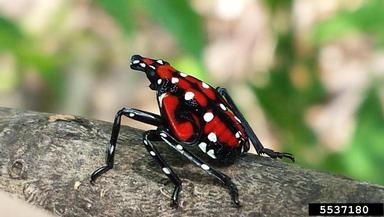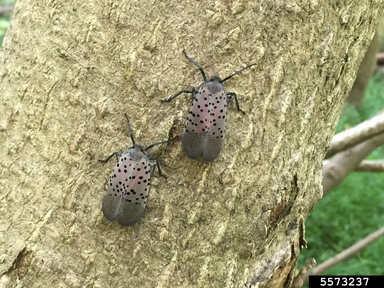One Year of Spotted Lanternfly in NC
go.ncsu.edu/readext?945622
en Español / em Português
El inglés es el idioma de control de esta página. En la medida en que haya algún conflicto entre la traducción al inglés y la traducción, el inglés prevalece.
Al hacer clic en el enlace de traducción se activa un servicio de traducción gratuito para convertir la página al español. Al igual que con cualquier traducción por Internet, la conversión no es sensible al contexto y puede que no traduzca el texto en su significado original. NC State Extension no garantiza la exactitud del texto traducido. Por favor, tenga en cuenta que algunas aplicaciones y/o servicios pueden no funcionar como se espera cuando se traducen.
Português
Inglês é o idioma de controle desta página. Na medida que haja algum conflito entre o texto original em Inglês e a tradução, o Inglês prevalece.
Ao clicar no link de tradução, um serviço gratuito de tradução será ativado para converter a página para o Português. Como em qualquer tradução pela internet, a conversão não é sensivel ao contexto e pode não ocorrer a tradução para o significado orginal. O serviço de Extensão da Carolina do Norte (NC State Extension) não garante a exatidão do texto traduzido. Por favor, observe que algumas funções ou serviços podem não funcionar como esperado após a tradução.
English
English is the controlling language of this page. To the extent there is any conflict between the English text and the translation, English controls.
Clicking on the translation link activates a free translation service to convert the page to Spanish. As with any Internet translation, the conversion is not context-sensitive and may not translate the text to its original meaning. NC State Extension does not guarantee the accuracy of the translated text. Please note that some applications and/or services may not function as expected when translated.
Collapse ▲Last month, we reached a milestone one year since spotted lanternfly was detected in North Carolina. The first active NC infestation of spotted lanternfly was confirmed on June 29, 2022 in Forsyth County. While the introduction of an invasive species is nothing to celebrate, reaching a year since initial detection without finding additional infestations certainly is! In the past year, sightings have been reported through the NCDA&CS See It – Snap It – Report It system. Thankfully, none have led to the discovery of another established population in the state.

Before becoming adults, spotted lanternflies are bright red and black with white spots. Image: Lawrence Barringer, Pennsylvania Department of Agriculture, Bugwood.org.
The spotted lanternfly is an invasive, sap-feeding insect native to China, India, and Vietnam. It was first discovered in the United States in Pennsylvania in 2014. Now present in 14 states, it poses a threat to agriculture, agrotourism, and is a significant public nuisance. Spotted lanternfly can feed on more than 100 species of plants and is particularly concerning for grape crops; feeding can reduce yield of grape vines by 90% and in some cases kill the vine. In addition, spotted lanternfly congregates in public areas and backyard and excretes a very sticky and very messy substance called honeydew.

Spotted lanternfly adults. Image: Emelie Swackhamer, Penn State University, Bugwood.org.
Keep your eyes peeled! This time of year, the spotted lanternfly is in its showier life stages. Before becoming adults, immatures (called nymphs) go through a colorful stage: they are bright red and black with white spots. They molt large, beautiful adults with spotted wings and red underwings by the end of the summer. Adults have already been observed in NC this year. As they become easier to spot, both due to size and their flashy colors, keep a sharp eye out wherever you go. If you suspect you see one, take a picture and report it!
As work continues to control the spotted lanternfly in North Carolina, we would like to take a minute to thank those who have reported sightings and have been mindful of their movement from and through infested areas. Your help in keeping this agricultural and nuisance pest at bay is greatly appreciated.
Written by Abigail Ratcliff


